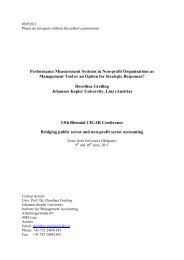WORKING PAPER - Faculteit Economie en Bedrijfskunde
WORKING PAPER - Faculteit Economie en Bedrijfskunde
WORKING PAPER - Faculteit Economie en Bedrijfskunde
Create successful ePaper yourself
Turn your PDF publications into a flip-book with our unique Google optimized e-Paper software.
perspective, and (2) the employee. The two surveys we have conducted provide a better insight<br />
into both parties’ views on what they believe to be important in terms of employee ret<strong>en</strong>tion and<br />
how this relates to outcomes (ret<strong>en</strong>tion practices set up by the HR manager and loyalty, int<strong>en</strong>tions<br />
to leave and job search behaviors by employees). A comparison of the results from both studies<br />
also provides information about the possible (in)effectiv<strong>en</strong>ess of the ret<strong>en</strong>tion practices HR<br />
managers set up. The samples we used in this study, which both <strong>en</strong>compass a broad range of the<br />
population of HR managers and employees, allow us to draw some g<strong>en</strong>eral conclusions which<br />
overcome the problems of external validity associated with single-organization samples or<br />
samples involving only one occupational group. Although our sample of HR managers was<br />
restricted to large organizations, they do repres<strong>en</strong>t a variety of both public and private sector<br />
organizations. The large sample of employees has diversity in terms of g<strong>en</strong>der, hierarchical level,<br />
occupational type, age and sector, which increases its g<strong>en</strong>eralizability and allows for some<br />
specific group observations. The fact that respond<strong>en</strong>ts from the employee sample participated<br />
indep<strong>en</strong>d<strong>en</strong>t of their employer can be considered as an advantage. We can assume that our<br />
respond<strong>en</strong>ts will probably have giv<strong>en</strong> more candid answers to the questions about employer<br />
contract fulfillm<strong>en</strong>t and about their loyalty, int<strong>en</strong>tions to leave and job search behaviors than if<br />
their employer would have be<strong>en</strong> involved in the study.<br />
One important limitation the reader should take into account wh<strong>en</strong> interpreting the results,<br />
however, is that both samples were not matched and thus our results provide no information on<br />
the correspond<strong>en</strong>ce or diverg<strong>en</strong>ce betwe<strong>en</strong> both parties’ views at the level of a specific<br />
organization. Further research is needed in which matched samples are used, making it possible<br />
to directly assess the impact of ret<strong>en</strong>tion practices, and of their perception and evaluation by both<br />
parties, on employee outcome variables. Moreover, this type of design would also allow for<br />
assessing the impact on organizational outcome variables (e.g. actual turnover rates).<br />
22
















